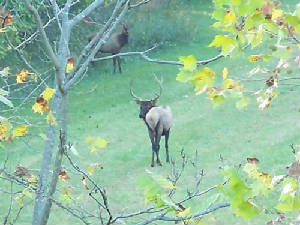|

THE FACTS ABOUT ELK

Elk (Cervus elaphus) are powerful animals
with large bodies and large antlers. Their meat is very nutritious and very delicious.
Elk are generally secretive.
For many sportsmen and sportswomen, the elk are the ultimate challenge.
North America today is home to more elk than
since the turn of the 19th century.
The estimations of the current elk population is a little more than 1 million
animals and growing steadily. In fact, there are so many elk that in some areas that the local public are calling for herd
reductions. The elk are eating more than their share of hay and other crops.
During the ice age, there were 10 subspecies
of the (cervus) in North America, of these, 6 are now extinct. The 4 remaining subspecies include:
ROCKY MOUNTAIN
ELK (Cervus elaphus nelsoni), is the most common elk and can be found throughout the West and have been transplanted in Pennsylvania,
Michigan, Virginia, Oklahoma, Arkansas, Texas, Kansas,Kentucky,The Dakota's and parts of Eastern Canada. Tennessee has recently
introduced elk and North Carolina is contemplating the idea. On the average, a mature bull can weigh around 700 pounds and
cows 525 pounds. This average weight can vary, depending on where they live.
Arizona
Colorado
Idaho
Kansas
Montana
Nebraska
New Mexico
Nevada
North Dakota
South Dakota
Utah
Virginia
Wyoming
States where elk have been transplanted and have a limited huntung season are as follows:
Arkansas
Kentucky
Michigan
Oklahoma
Pennsylvania
Tennessee--- has re-introduced elk but as of yet does not have a huntable population:
ROOSEVELT ELK (C.e. roosevelt),are the largest bodied elk and are found in the
rain forest of the Pacific Northwest, from Northern California up through Oregon and Washington, Coastal British Columbia
and Vancouver island and some islands in Southeast Alaska as well as Afognale and Raspberry Islands Alaska. these mature bulls
can weigh between 700 and 1100 pounds. Cows can weigh between 550 and 625 pounds.
Alaska
California
Oregon
Washington
TULE ELK (Ce. nanrodes),is the smallest elk. Tule elk lives only in various
places throughout California. Before the mid 1800's, there were an estimation of 500,000. Today there are only about 3,100
Tule elk. These mature bulls weigh just 400 pounds and cows average 325 pounds.
California
MANITOBA ELK (C.e. manitoberis, is the second largest elk. You will find Manitoba
elk scattered in the Southwestern corner of Manitoba, southern half of Saskatchewan and southeastern Alberta. These mature
bulls can weigh about 800 pounds and cows at about 600 pounds.
Of the North American deer family, the Elk is the second largest member, with
the Moose being the number one largest member of the deer family.
Elk have 32 teeth including the "ivories" so prized
by hunters. These are not real ivory, instead incisiform canine teeth or better known by the terms of "whistlers" " buglers"
and elk teeth. These two teeth are located in the forward portion of the upper jaw, one on each side.
Elk antlers
are of course what hunters dream about. They are a very fascinating part of the animal's body. A mature Rocky Mountain bull
elks antlers usually consists of a long main beam between 40 and 60 inches, that sweeps up and back from the head. These long
main beam are home to between two and six distinct tines or points. Non-typical points are possible as well. The first two
tines called the brow and bez tines grow close together at the base of the skull, protruding outward from the bull's face.
The third or trez tine begins farther up the beam usually angling forward. the fourth point is called the "royal" point. This
point is generally the longest and is usually the most dominant feature of the entire rack. The fifth point grows off the
main beam behind the royal point. Forms a fork with the end of the main beam, which is always counted as a point also. Most
mature bulls grow no more than six points per side. Some old larger bulls never grow more than five points. A few will grow
seven, eight or even nine points, but this is vary rare! A full set of antlers from a mature bull will weigh between 20 and
30 pounds.
A bull elk will expend as much energy growing a set of antlers, as a cow will, in growing her new calf.
The growth of a three or four year old bull's antlers takes about 140 days to grow. A two year old bull takes only about 115
days to grow.
Elk calves are usually born in the summer, normally around early June. The cow carries the calf between
8 and 81/2 months. At birth a calf can weigh between 25-30 pounds. The elk's calving grounds consists of tall grassy meadows
with dark timber around for escape. For the first 2 to 3 months after birth, cows and calves will stay away from the herd.
After this, the cows and calves and young bulls herd up. This number could be up in the hundreds.
These animals have
played a prominent and special part in North America's history. Natives used their flesh and fat for food, their hides for
shelter and clothes. Toys, tools and ceremonial articles were crafted from elk bones, hides, antlers and teeth.
Now
in the modern West, elk still continue to play a prominent role in shaping their future. Land management planning and decisions
are rarely made today without considering the impact on wildlife and elk are often number one!
|




